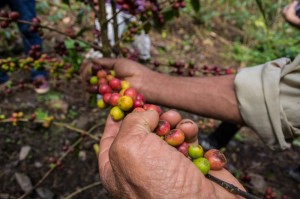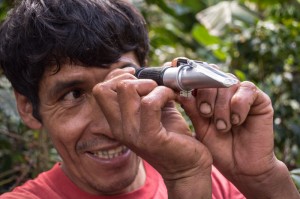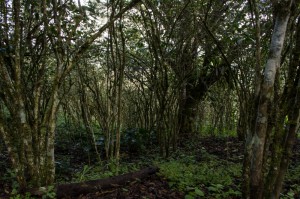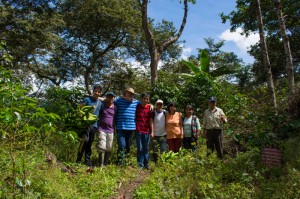Coffee Growers Fight the Devastating Fungus Roya

Peru’s coffee industry faces a crisis. If you go into the fields you will see it, coffee tree after coffee tree skeletal and leafless, though often its branches still have coffee fruit hanging and ripening. The trees are dying and the coffee fruit suffers from low quality.
The situation is so bad that the Peruvian national government made a formal declaration of a state of emergency last year in the country`s coffee growing regions. Though only in force for sixty days, the problems that motivated the state of emergency continue to threaten coffee, one of Peru’s major exports.

Like other coffee producers in the Americas, Peru’s coffee growers, mostly small-scale, family farmers, face potential disasters because of the spread of a fungus called roya in Spanish and coffee rust in English.
No one knows exactly what has caused the current outbreak of coffee rust, according to researchers at the World Coffee Research at Texas A and M University. It seems a combination of variables, but the massive spread of the rust throughout coffee fields in this hemisphere has everyone concerned.
There are two things that the experts and farmers, such as those I spoke with in the Yanatile and Ocobamba districts of Cuzco: climate change and differential resistance of different varieties.

Temperatures are rising throughout the world, although not evenly. In Yanatile people were uniformly complaining about the effect of this. They said it was not only impacting coffee fields but also the coca fields.

Lower elevation coffee was the most impacted, according to what I was told. As a result people are pushing coffee cultivation into higher elevations where they can, to resist the rust.
Quality of coffee also depends on cooler temperatures at night, which are increasingly difficult to find given global warming.
Nevertheless, farmers following the advice of government extension agent are planting new resistant varieties, even if the resultant quality of the coffee is not quite to the level of the more impacted strains of coffee.

In Yanatile and Ocobamba, from what I am told, the most impacted strain is the tipico, which is what they traditionally grew in the region. Stands of tipico coffee, some a decade old or more, stand like ghosts due to the rust.
Extension agents are encouraging farmers to cut them down and plant mondo novo, a Brazilian variety, borbon and catimor. These plants are more evenly planted and often have two plants to a hole. They require much more in the way of care to produce good coffee and resist the rust, according to what they told me. As a result, it is more expensive to produce rut resistant coffee.
Many farmers in the Versalles area of Ocobamba and in Yanatile face added difficulties with this. They realize their best bet is to shoot for a fine quality of coffee that they can export under their own brand in order to obtain much higher prices and mitigate the cost of rust control and climate change.

To do so, they are seeking certification as organic and for fair trade. However, were they to use the fungicides that many coffee regions have come to rely on, or commercial fertilizers, they would not be able to obtain those. Instead they rely on guano (bird dung) from the coastal islands off Peru´s coast and on compost they make themselves.
In the fields I walked through the new plants are now three years old, about the time the roya has been striking hard, and are producing their first crop. Farmers are excited to see what the harvest will bring.
But because the rainy season has been delayed this year, the harvest has also been delayed, creating more stress in the farmers. Nevertheless, their new plants growing in the shade of bananas and mostly tall, wide-spreading pacay trees are covered with cherries in various shades of ripeness.

To increase the quality of output, and reduce waste, some farmers are talking of selective harvesting: gathering only those coffee cherries that are at the peak of ripeness. Though much more labor intensive, these farmer hope this will give them a competitive advantage and hence higher prices.
The roya epidemic is far from over. Farmers are adapting by trying a variety of techniques. Governments and academics are looking for long term solutions. USAID and Texas A&M University have announced a major initiative, involving an investment of 5 million dollars, to combat the rust and save coffee for future generations of people who need that hit at the start of the day.




